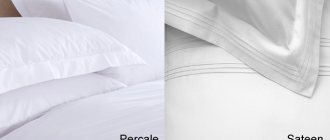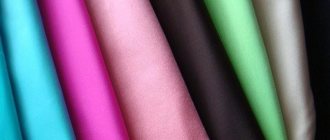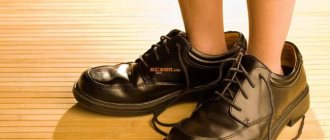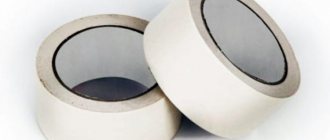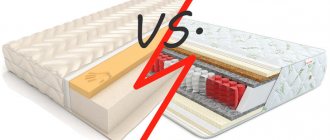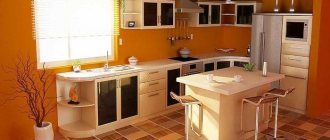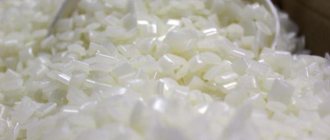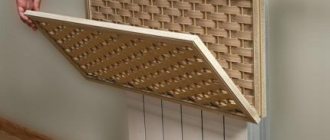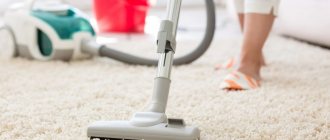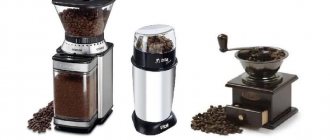Fastener retention
Chipboard has long gained the reputation of a “disposable” material - furniture assembled from it is very difficult to disassemble without loss, transport to another place and reassemble. This is due to the fastenings, which, even if the screws are screwed in and out perfectly evenly during reassembly, at best will hold much weaker. The worst is also the more likely outcome - the attachment point will simply crumble and you will have to additionally treat it with glue or use screws of larger diameter.
As a result, if you have a choice, then you should take furniture made of chipboard, in which not screws are used as fasteners, but bolted connections with wide washers. If they break, then you won’t have to worry about the possibility of restoring the fasteners.
MDF, due to its density, easily tolerates repeated assembly and disassembly - in this, again, it is not very different from natural wood.
Which is better: chipboard or MDF
There is no clear answer to this question, because... materials differ in several basic parameters. Let's look at some of them.
Furniture made from chipboard is much cheaper than furniture made from competitive raw materials. This is due to several factors. Firstly, chipboard is a more common option, which means its production has long been put on stream in many factories. Secondly, processing of raw materials is less expensive, because does not require special preparation. The finely dispersed fraction of wood requires a more careful approach. This includes special equipment that dries fibers and pressing machines that require a large area of production premises.
Nowadays, cabinet furniture is rarely made only from MDF, because the final product will cost a fabulous amount. Most often it is used for facades, where more elegant carving is required. And the side walls are often made of laminated chipboard, and the rear walls are made of plywood.
Appearance
The structure of MDF is more flexible in terms of finishing, which means it can be given any shape. That is, carved headboards or cabinet fronts will look more like natural wood. Moreover, there are products that at first glance cannot be distinguished from wood. Of course, it will cost more (see point 1), but it looks more respectable than furniture made from chipboard.
However, furniture made from laminated boards is more variable in terms of color, because the film covering it can not only have any color, but also imitate the color of natural wood. Of course, it is more difficult to give it texture, so the coating simply copies the shade very accurately.
Safety
MDF is a more modern material, which means its production technology has been worked out to the smallest detail. Manufacturers, competing with each other, are trying to use innovative technologies that every year make products safer for use in residential and children's premises.
However, laminated chipboard manufacturers are not lagging behind and are also using new developments that make their products quite competitive. Every year the amount of resins and formaldehydes in the composition decreases, which means the safety of such slabs increases. At a higher cost, it is still worth giving preference to E1 class chipboard, especially if you plan to install this furniture at home and not in a public place.
Wear resistance
The durability of a material depends not only on its composition, but also on operating conditions. For example, in the kitchen and bathroom, any furniture can become deformed under the influence of moisture and temperature changes. The service life is also affected by the microclimate in the room, which, in turn, may differ in winter and summer.
Processing technology and edge material are of no small importance. Modern factories use such types of processing as postforming and softforming
There are no fundamental differences between them, the first one is simply used for products of simple shape. The laminating film is wrapped around the product and completely sealed to the edge.
The softforming method also involves special processing of the edges; its cut is rounded to the front side, which makes the corners of the furniture safer for small children. Both of these methods prevent moisture from entering the edges and inside the slab, which means it will not swell or deform. Both of these methods are great for kitchen and bathroom cabinetry.
Materials that can be used to process the edges of products not intended for wet areas can be:
They do not protect against water ingress very well, but they affect the final cost of the product. Unlike the first two methods, these options are less expensive, but can add zest to the appearance of the furniture. Contrasting or metallic finishes look interesting and extraordinary.
As for the wear resistance of MDF and laminated chipboard, the first option is considered more durable. But due to its high cost, it makes sense to use it only on furniture facades, and make the rest of the array from chipboard. Moreover, the wardrobe in the bedroom is unlikely to be subject to frequent moisture.
To summarize our article, we can say: before giving preference to one material or another, you need to decide under what conditions the furniture will be used. It is better to choose kitchen units with facades made of MDF with edge processing using the softforming or postforming method. And for a simple chest of drawers or cabinet, a more budget-friendly chipboard with acrylic or aluminum edge is quite suitable.
What is the difference between laminated chipboard and MDF?
Each of the materials has found its application in furniture production due to its structural features and performance characteristics. Comparing the main indicators will help you understand the difference between MDF and laminated chipboard and make the right choice.
High strength is one of the main properties that furniture materials should have. Dense MDF board is much stronger than chipboard and even solid wood. Products made from chipboard are also quite resistant to mechanical loads that may arise when using furniture in domestic conditions. The main weak point of chipboard parts is the attachment points of hinges and fittings: due to the loose structure, gradual destruction of the material is possible.
Resistance to moisture and steam is especially important when choosing furniture for the kitchen or bathroom. Parts made from chipboard behave well in rooms with normal or slightly increased (in the kitchen) humidity, provided that the cuts and joints are processed with high quality. Through unprotected or damaged surfaces, moisture easily penetrates into the chipboard, which leads to swelling, disruption of geometry and destruction of elements. MDF parts are much more resistant to high humidity and can even survive a flood.
When choosing materials for furniture, technological capabilities are important. Deep milling and drawings can be applied to a dense MDF board, which provides unlimited design space in the production of furniture facades and decorative elements. Laminated chipboard does not provide such opportunities - a loose surface cannot be processed efficiently with a milling machine. MDF bends quite easily - this allows you to make parts with streamlined shapes. Only straight furniture elements are produced from laminated chipboard.
In terms of environmental friendliness, MDF is close to natural wood; the absence of harmful substances allows this material to be used in any residential premises. The use of chipboard is limited in children's rooms and hospitals.
Cost is often a deciding factor when choosing furniture. MDF is 1.5–2 times more expensive than chipboard and is used for the manufacture of premium and luxury furniture. Economy segment products are almost always made from laminated chipboard.
The cost of MDF facades can vary significantly depending on the type of finishing material. The most economical coatings are PVC film and sheet plastic, higher on the price scale is enamel (painting), the most expensive finish is natural wood veneer.
Difference between panels
Despite the popularity of both types of slabs, each of them occupies its own niche in the furniture business. The materials differ:
By density
- MDF is a dense and moisture-resistant material. Its structure is strong and lends itself to fine processing. Used in carved cabinets, headboards and other places where grace and fine lines are required. Products made from MDF are durable and massive.
- Laminated chipboard is a loose material that strongly attracts moisture. It has a durable façade surface, but is inferior to MDF in terms of fracture strength. The material suffers in the fastening areas due to frequent disassembly and assembly or dragging of pieces of furniture. Laminated chipboard is 2 times inferior in strength to fibreboard. At the same time, the laminated protection makes the chip structure stronger, while at the same time protecting it from moisture and temperature. Therefore, laminated chipboards are popular in the manufacture of kitchen sets and bathroom furniture.
Environmentally friendly
- MDF is close to wood in nature and is allowed for all premises.
- Laminated chipboard contains toxic components (formaldehyde), which limits its use in areas where children and patients are present.
By design
- The design of MDF panels is limited.
- Laminated chipboard has many colors and textures due to the laminated coating. Chipboard panels are used to make cabinet furniture with an imitation of any wood.
By cost
- MDF is expensive. Used in the manufacture of luxury furniture.
- The price of laminated chipboard is more affordable. The facades of economy-class cabinet furniture are mainly assembled from laminated boards.
Advantages of MDF
- Since formaldehyde resins are not used in the production of MDF boards, they are much safer than chipboard. In fact, it is the same wood, with a small content of natural or urea resins, only more uniform and durable. The material is used in the manufacture of children's furniture, cribs and changing tables for newborns, products for children's and medical institutions. By purchasing furniture made from high-quality MDF, the buyer can be completely confident in its safety for health.
- MDF, even in its natural, uncovered form, is not afraid of water. Its dense structure simply does not allow liquids to be quickly absorbed, unlike some types of natural wood and, especially, chipboard. And an additional protective coating in the form of a laminating film or veneer gives it excellent moisture-resistant characteristics. Even many hours of exposure to puddles of water or other liquids are not dangerous for MDF surfaces. That is why furniture made from this material is recommended for “wet areas” - kitchens, bathrooms, swimming pools, toilets, dressing rooms.
- Dense sheets can be bent if necessary: they do not break or crack, and retain their shape perfectly. This feature is widely used in the manufacture of curved or concave facades and other elements.
- MDF sheets, thanks to their homogeneous structure, make it possible to produce richly decorated furniture facades. They perfectly withstand all types of processing: sawing, shape cutting, milling. The possibilities of milling this material are limited only by the designer’s imagination. Craftsmen form products with relief figures and designs, carve complex recesses and patterns, apply entire pictures to slabs, and make carved platbands and moldings.
- The edges and front part of the products have no joints or seams, as they are covered with one sheet of protective and decorative material. That is why products made from MDF successfully resist moisture and chemicals. The coating is so dense that it is very difficult to scratch or make a dent.
- You can spill water, caustic fruit acids, or soda solution on MDF countertops and kitchen aprons. If you wipe up the resulting puddle in a timely manner, there will be no consequences for the coating.
- Furniture made from MDF perfectly withstands repeated assembly and disassembly when moving and moving to other rooms. In this respect, it is comparable to products made from natural solid wood.
- Consumers are offered a huge number of finishing options: PVC film with the most fantastic shades and textures; glossy, mirror, matte and semi-matte coatings; products with metallic, mother-of-pearl effects, interspersed with sparkles and metal threads, patina; veneer from elite wood species; surfaces that perfectly imitate any type of wood, stone, textiles, leather. Even the most picky buyer will definitely find a product to his liking!
Structure of MDF and laminated chipboards
In furniture production, two types of working raw materials are popular - MDF panels and laminated chipboards. Despite the fact that both technologies are based on the use of natural wood, the differences in the structure of the materials are obvious.
MDF is a board made from fine wood fraction. To obtain the panel, wood dust is dried, impregnated with binding compounds and subjected to hot pressing. The impregnations are based on natural fillers: paraffin and lignin, which do not emit toxins.
Laminated chipboard is a chipboard with a laminated coating. The wood replacement panel is formed from pressed shavings and sawdust. The contents of the slab are bonded with formaldehyde resins. High-quality products have three layers: an internal one, which consists of large fractions, and two external ones - from small ones.
The laminated film is pressed into the chipboard. The coating makes the wood structure stronger, protects it from moisture and at the same time serves as a cladding. The film includes a paper base and melamine resin (a synthetic compound with the properties of formaldehyde resins).
We advise you to study - User ratings of ovens for electric and gas models
What is better for kitchen furniture? How are these materials different?
At first glance, it is difficult to understand how MDF differs from chipboard. Experienced people can immediately see the differences, but beginners, even after several years of use, cannot guess the difference. The undeniable advantage of the first is its environmental friendliness, which determines high operational safety, although the cost of the material also dictates its own rules. If you have the financial means, you should choose furniture made entirely from MDF for your bedroom and children’s room.
The ability of laminated chipboard to withstand high levels of indoor humidity has made it a frequent companion in bathrooms and kitchens. It is difficult to imagine more suitable inexpensive furniture for these rooms. At the same time, with poorly laminated joints, chipboard tends to absorb moisture. In order for such furniture to serve for a long time, you need to carefully inspect all ends of the product. At the same time, this allows you to make sure that furniture made from chipboard is safe for use.
If the cost of MDF were comparable to the price of laminated chipboard, then the choice would be obvious - fine wood fraction. This is not yet the case - laminated chipboard is cheaper than its competitor, which determines its demand among consumers.
Combinability of materials
Many will not be able to determine whether it is laminated chipboard or MDF by appearance. The visual differences between them are understandable only to experienced people. If the product has a clear rectangular shape without relief and angled ends, then even professionals who know the difference between MDF and laminated chipboard will not immediately identify the differences.
This approach to combining materials allows you to use the aesthetic characteristics of the fine wood fraction without spending a lot of money. From the point of view of operational safety, everything remains the same - chipboards must be protected from chips.
Comparison of characteristics
To choose the most suitable option for rough or fine finishing of a floor structure, it is necessary to take into account the main parameters of the product.
Environmental friendliness
Health safety is one of the main factors. The indicators of wood-based panel materials comply with the standards reflected in standardization documents.
- Plywood. Eco-friendly option. The most harmless products are those that are glued using natural resins.
- OSB. It does not pose a threat, but only if the production technology is followed. It is better to choose trusted manufacturers.
- Chipboard. This variety causes the most controversy regarding health hazards, since formaldehyde resins are used for gluing. Products must comply with standards (marking E1 or E0.5).
- Fiberboard. Does not pose a threat provided that high-quality raw materials are used.
- MDF. Eco-friendly material made using urea resins. These products must also comply with class E1 or E0.5.
Since the outside of all materials is finished, harmful fumes are minimized.
Strength
To choose the most reliable option, you need to take into account the density and structure of the product:
- OSB and plywood. Oriented strand panels can withstand heavy loads well: the layers are placed in different directions and glued together extremely firmly. But wood-laminated board may have a significant disadvantage - the possibility of deformation due to non-compliance with the technology.
- Chipboard and fibreboard. They have sufficient hardness. Their areas of use are somewhat different. Wood-shaving parts are thick, and wood-fiber parts are very unstable in bending, so they cannot be used for leveling voids.
- MDF. A relatively soft material that is not used in places with high loads.
It is difficult to compare all products on this parameter, since they have different sizes.
Dimensions
The length and width of all varieties are approximately the same, so it is necessary to compare the thickness:
- Hardboard. The thinnest material. Its thickness can reach up to 7 mm, but the most common is 3.2 mm.
- Plywood. For the floor, products with a thickness of 12–15 mm are selected.
- OSB. Can be of different sizes, but for flooring options from 10 to 22 mm are used. If you need to level the existing base, then a thickness of 1 cm is suitable, but in order to lay the material on wooden logs, the parts must be more durable.
- MDF. Due to their softness, the recommended thickness of the slabs varies from 18 to 25 mm.
- Chipboard. For horizontal structures with increased load, a tongue-and-groove version with a thickness of 16–22 mm is used.
The thickness and structure of the parts also affects protection from sound penetration and heat retention. If the noise pollution is very strong, then it is recommended to give preference to medium-density fiberboards of maximum thickness. They also serve as additional thermal insulation, which is similar to OSB.
Price
The difference in the price of materials depends on many factors: production method, raw materials used, additional processing, size and even place of sale.
- The most expensive is high-grade plywood.
- The cost of MDF is calculated per square meter and depends on the manufacturing method.
- The price of OSB-3 and 2 corresponds to wood-laminated boards of grade 3 or 2 of a smaller size.
- The lightest and cheapest option is fiberboard.
To ensure that the total work budget does not amount to too significant an amount, it is necessary to immediately determine the scope of application of each type of product.
Easy to install
Laying wood boards is not difficult; it does not require professional skills or complex tools. The order of work depends on the specific situation:
- If a frame structure is being erected, then OSB would be the best option.
- The light weight and thickness of hardboard make processing the fastest, but it is not suitable for serious leveling.
- Chipboard and OSB panels are cut and fixed almost identically. They are much easier to trim than MDF, which due to its dense structure offers more resistance.
- The most labor-intensive material to process is plywood. It will take much longer to place the product. It is more difficult to drill or adjust to size due to the presence of layers of natural wood in the structure.
All floor slabs are mounted on glue or joists, the only exception is the fiberboard covering: these sheets are not intended for laying on joists, they need a flat and durable base
Properties of MDF
First, it is worth considering the most important properties of each material separately. As for MDF, it is a board made from fine wood fraction. It is dense, resistant to mechanical stress, thickness varies from 2 to 60 mm. The name MDF comes from the English abbreviation MDF, which means “medium density wood board”.
Note! MDF is absolutely safe for health, does not emit toxic fumes, and is similar to natural wood. A distinctive feature of MDF is its plasticity and the ability to be processed with cutting and drilling tools.
It is easy to make holes and grooves in the slabs, cut out patterns on the surface, and chamfer them with a router. The sheets can be bent to obtain radius facades. This allows you to make furniture of a wide variety of configurations
A distinctive feature of MDF is its plasticity and the ability to be processed with cutting and drilling tools. It is easy to make holes and grooves in the slabs, cut out patterns on the surface, and chamfer them with a router. The sheets can be bent to obtain radius facades. This allows you to make furniture of very different configurations.
The surface of the plates can be sanded, covered with PVC film, painted with glossy or matte enamel of any color. When pasted with natural veneer, the material is difficult to distinguish from solid wood; in appearance it is very similar to it, and even superior in strength.
Furniture made from MDF can be installed in rooms with humidity reaching 70%. There are also more moisture-resistant modifications with special impregnation; slabs with fire-resistant properties are produced. Furniture made from this material is great for the kitchen, bathroom, bedroom, and children's room.
Video: difference between MDF and chipboard
Also, when using furniture made from combined materials in the kitchen, it is worth remembering that MDF is afraid of high temperatures. It is necessary correctly to avoid heating them from a nearby stove or hob. This will avoid peeling of the coating on the finished product.
My dear readers!
I always read your comments with great interest.
to my articles.
If you have any questions, do not hesitate to ask them,
please
leave your feedback
in the form below. Your opinion is very important to me. Thanks to your criticism and gratitude, I can make this blog more useful and interesting.
I would be very grateful if you rate this publication
and
share it with your friends
.
This is easy to do by clicking on the social media buttons above. Don’t forget to bookmark
and
subscribe
to new blog posts on social networks.
I'm ready to spend money on renovating my kitchen.
- up to RUB 150,000 (70%, 5,420 Votes)
Total voters: 7 793
What is the difference between chipboard, MDF, plywood, furniture board, lumber, veneer?
A little discussion about furniture materials: chipboard, MDF, plywood, furniture board, lumber, veneer.
Choosing furniture materials can seem daunting. And yet, if you understand the essence of the issue, the choice will always be elementary. About this video. Watch, ask questions, comment...
Today I want to answer this question: What is the difference between the materials used to make furniture? Today, the following materials exist: chipboard, MDF, plywood, furniture board, lumber, veneer. Let's talk specifically about each of them.
Chipboard
is a shortened abbreviation of the full name: particle board.
A modern composite material obtained by pressing wood particles (sawdust and shavings), formaldehyde resins are used as a binder. Interesting fact from Wikipedia: “Chipboards appeared in the 1940s in the USA (
eng.
Chipboard) for temporary furniture of American refugees.”
An appropriate explanation that once again reminds us why and for whom chipboard furniture was originally invented.
Let us next consider the operational characteristics of chipboard. One (and probably its only positive characteristic) is stability. Products made from chipboard retain their shape, color and size under normal room conditions. This is a dead material and, in comparison with wooden furniture, does not require maintaining relative air humidity, unless you completely fill it with water.
The next indicator that directly affects the life expectancy of furniture is strength. Anyone who has had furniture made of chipboard (most likely each of us) knows how fragile this material is. Despite the external solidity, which is created by a thin layer of plastic (laminated chipboard), inside it consists of sawdust and shavings. And chipboards may differ in their density, which is immediately visible on the cut. Loose chipboard will not last you even a year: hinges will immediately fly out of it, shelves may break due to the weight of books, chips may appear, etc. Such furniture cannot be repaired, don’t even hope! If you are lucky and have purchased furniture made from higher quality dense chipboard, it will last you a maximum of 10 years. But only under the condition of proper use: do not hit corners, do not scratch and do not pour water on it. If you want to disassemble and reassemble such furniture, keep in mind that the third time you will not be able to screw in the screws.
But these are only the visible disadvantages of chipboard furniture. An important environmental indicator is that it has a hidden but targeted effect on the health of consumers. The cause of this is the binding resins, which emit formaldehyde, which is harmful to humans. The maximum permissible emission of harmful substances is determined by sanitary standards. But do all manufacturers comply with these requirements? Low-grade cheap slabs sometimes exceed the maximum permissible concentration by up to 40 times. Slabs of this class are no longer produced abroad (in Europe and the USA), and only ultra-safe “Super E” class slabs are allowed to be used for furniture production. New furniture, from which active formaldehyde particles have not yet evaporated, is especially dangerous to health.
We advise you to study: Selecting and laying a cork underlay under the laminate
Therefore, when purchasing, you should especially pay attention to the tape on all ends of the furniture, even those invisible from the outside. Use your sense of smell and sniff
Furniture made from chipboard with a high concentration of formaldehyde has a pungent, unpleasant odor. But often, what stands as a sample is not always what will be delivered to your home.
What is the difference between MDF
(Medium Density Fiberboard)
and chipboard?
It is classified as a less toxic material, since the slabs are formed by dry pressing of fine wood chips at high pressure and temperature. Urea resins modified with melamine are used as a binder. This ensures very low formaldehyde emissions, comparable to those of natural wood. Therefore, it is considered a more environmentally friendly material and is widely used in furniture production. The strength of MDF exceeds chipboard by about 2 times, slightly increasing the service life of furniture. Unlike chipboards, MDF is a moisture-resistant material, especially if it is coated with varnish and enamel. It is practical to use such furniture in a bathroom where there is constantly high humidity.
Laminated chipboard - what is it?
Chipboard (chipboard) is compressed wood sawdust and shavings; formaldehyde resins are used as an impregnation and binding composition. The slab has a heterogeneous structure; the density, depending on the grade, is 300–600 kg/m3. For the production of furniture, types with high performance are used. More loose varieties are used for technical purposes or as packaging material.
Next, the chipboard is laminated - covered with a layer of melamine film under high pressure. The result is a laminated chipboard (laminated chipboard) material that is ready for use in furniture production.
The coating performs several functions:
- prevents the release of formaldehyde, which is quite harmful to the human body;
- protects the stove from external influences and moisture;
- gives the slab an attractive appearance - laminating films of various colors, decors and textures are used to make furniture laminated chipboards.
There is an international classification of the environmental safety of laminated chipboard. High-quality material used in the manufacture of household furniture must comply with class E1. When purchasing, check with the seller and ask to see certificates. Products of class E2 are completely prohibited in Europe and have significant restrictions on use in Russia.
What is MDF ↑
MDF, MDF - MediumDensityFibreboard (medium density fiberboard 600–800 kg/m3). The same board of wood particles, produced by dry pressing under high pressure and temperature conditions. Urea resins containing formaldehyde are used as a binder, but the emission of harmful substances is much lower than that of chipboard and is comparable to that of natural wood. Significant reductions in emissions are achieved by modifying resins with melamine.
MDF
The resin is produced in several stages:
- polycondensation in an alkaline environment;
- polycondensation in an acidic environment;
- additional introduction of urea and drying until the required viscosity is achieved;
- cooling;
- modification.
Synthesis requires compliance with the temperature regime - 88–94°. The resin is modified at a temperature of 40–50°.
Despite the same raw materials, MDF is very different from chipboard (without taking into account the difference in emission values): the material can be milled and deformed, which opens up the possibility of producing carved furniture facades, furniture and other designs of radial shapes.
Milled part
MDF is divided into four types according to operating conditions (humidity, temperature). The first type is used for the manufacture of office and home cabinet furniture and commercial equipment (normal conditions), the second - kitchen furniture (humidity, steam), the third - structural elements (normal conditions, high load), the fourth - structural elements (high humidity, high loads) ).
During the production process of slabs, they are given fire resistance, water resistance, and biostability (protection from fungi and bacteria). MDF requires additional processing of the front surface. According to the type of processing, the material is divided into:
- Veneered: thin natural veneer is glued to the front (sometimes also the inside) surface; this is an expensive type, and the price varies depending on the value of the type of wood used to make the veneer.
- Painted: surfaces (one or both) are coated with paint or enamel
- Laminated: the front side is covered with PVC film - matte or glossy, imitating various surfaces (wood, natural stone, marble, etc.); The film is applied under pressure at high temperature.
Surface treatment improves the physical and mechanical characteristics of the material, its operational and aesthetic properties.
Painted glossy slab - examples of some shades and curves
All types of MDF are in equal demand - each has its own niche. Material with a front surface made of natural veneer is used to make good office furniture and commercial equipment, furniture for kitchens, living rooms, and hallways. The cheaper one, laminated with a film that imitates wood, is used in the production of the already listed, but relatively inexpensive mass-market furniture.
The material was developed specifically for creating curved surfaces, which are actively used in modern design. MDF can be milled - this is precisely the quality that is used in the manufacture of flexible boards: parallel slots are made on one side, due to which the panel can be bent to a certain radius (depending on the thickness); the other side remains flat. In this way, surfaces of varying complexity are obtained - from a banal circle to a wavy one with different radii of each wave. This type of MDF is called perforated MDF (not to be confused with perforated HDF). The material opens up almost limitless possibilities in furniture design.
Not a single flat facade - all with one radius or another
What is laminated chipboard? Pros and cons
Chipboard, what is it? This is a particle board made by pressing wood elements with formaldehyde resin. After manufacturing, the slab is covered with a special polymer film.
This material is used to create any economy class cabinet furniture.
Advantages of laminated chipboard:
- Variety of colors. The surface of laminated chipboard can be of any color, matte or glossy.
- Easy care. Furniture and this material can simply be wiped with a damp cloth.
- Durability. With proper care and compliance with operating rules, such furniture will last for many years.
- Price. The advantage of laminated chipboard is, first of all, low price with good quality.
Disadvantages of laminated chipboard:
- Chipboard is afraid of moisture.
- Reacts poorly to sudden temperature changes.
- Formaldehyde resins are toxic.
At first glance, it seems that laminated chipboard is not suitable for the kitchen. But that's not true. With high-quality processing of the ends, such a kitchen is perfectly preserved.
Safety class
Due to the fact that the resins used in the manufacture of chipboards are quite toxic, when choosing furniture it is necessary to check the quality certificate . There are several security classes:
- E0. This is the safest furniture, the admixtures of harmful substances are kept to a minimum. This furniture is suitable for children's rooms. It is also used in medical institutions. Unfortunately, there is no furniture production of this class in Russia.
- E1. Furniture of this class is produced by domestic manufacturers. The content of harmful resins is low and does not harm health.
- E2 and E3. The manufacture of furniture from laminated chipboard of this class for residential premises is prohibited in Europe. Russia does not have such a ban. The production of children's furniture from such chipboard is prohibited in Russia.
Features of MDF
MDF (fibreboard) has a fine fraction. Its name originates from the English abbreviation MDF - Medium Density Fiberboard, which means “high-density fiberboard”.
The material is obtained by pressing crushed and dried wood fibers, which, under the influence of high pressure and high temperature, release lignin - an adhesive substance, which makes it possible to do without additional fastening compounds.
During the production process, raw materials are sometimes treated with paraffin. Wood fibers are glued together with the help of these binders, forming a smooth surface. Such slabs are easy to process and can subsequently be given different shapes. The resulting material is superior to solid wood in some characteristics.
Types and features of material:
- Colored. Regular fiberboard is primed, then several layers of paint are applied to it. The top surface is varnished. The color range is extremely diverse. Designers create exclusive furniture from this material.
- With PVC film (polyvinyl chloride). It protects facades during operation and creates various imitation of wood surfaces. The film is applied through a vacuum pressing process.
- Acrylic. A type of plastic coating that has a beautiful shine with iridescence.
- Frame. A budget option, the texture is close to wood and allows you to create interesting facades. Perfectly combined with glass, rattan, mirrors and other materials that are inserted into an MDF frame.
These types of slabs are used for the production of kitchen units, and some are used to create doors or floor coverings.
Benefits of using it in the kitchen
MDF has high performance properties. Products are sometimes superior to wooden analogues, as they tolerate high humidity well. Only natural raw materials are used in production, so the products do not have a negative impact on human health.
- Price. Such headsets are cheaper than wooden ones.
- Wide possibilities for design. The slab is taken as a base, and the top is finished with plastic, film or acrylic.
- Durability. Furniture lasts 15-20 years and does not lose its former qualities.
- Easy care. The facades are not capricious and do not require the use of special detergents.
- Flexibility. The panels are used to create models of sets of various shapes.
- Ease and speed of installation.
When decorating kitchens, designers often use glass and mirror inserts that harmoniously fit into any style of furniture.
Flaws
The main disadvantage of the slab is its limited design possibilities.
Rapid flammability is the main problem of raw materials. Designers advise protecting surfaces from possible contact with open flames and hot objects.
You should also pay attention to the wiring that runs next to the headset. Susceptibility to mechanical damage. There is no need to be afraid of light impacts, but with strong impact the appearance of the slab may deteriorate. Hardness
It is necessary to drill additional holes for fasteners, since the material does not allow tightening a screw or driving a nail without the use of additional tools. Price. A set made of MDF is more expensive than one made of chipboard.
Kitchens will last a long time if they are made by a reputable manufacturer in accordance with quality standards.
Features of laminated chipboard (chipboard)
LDSP is a well-known chipboard coated with a facing film.
The technology for manufacturing such boards has been known for a long time; in the 80–90s, furniture made from chipboard was one of the most popular. Later, obvious shortcomings were identified, which somewhat reduced the popularity of this material. At the same time, a simple chipboard has fewer advantages than its counterpart with a laminating film on top of the board.
Advantages of the material
- different sheet thickness;
- high hardness;
- widest choice of colors;
- good tolerance to humidity and high temperatures.
Furniture made from laminated chipboard has long proven itself. Many are satisfied with the price-quality ratio, as well as the long service life and ease of maintenance.
Disadvantages of laminated chipboard
One of the most critical disadvantages of laminated chipboard is toxicity. When making this type of particle board, formaldehyde resins are added to the mixture before pressing, which ensures adhesion and rigidity.
When purchasing furniture made from chipboard, you should pay attention to the class of the material. The E1 indicator indicates less toxicity of the components. At the same time, it is always worth studying the quality of lamination of joints - they should be covered or covered with special corners made of plastic, rubber or metal.
In addition to the toxic effects due to poor-quality assembly or damage to the laminating film, there is another disadvantage. It is not so significant; for some this disadvantage does not even matter. Due to the high hardness of the material, it is impossible to create relief patterns on the surface using milling machines. Instead of a beautiful relief, chips will appear on it, so the surface remains simply smooth. It is possible to create a slight imitation of the relief structure of wood or stone through the use of a special plastic film.
What material to choose for the bedroom and nursery?
A bed is a place where you spend at least 6-8 hours every day. Obviously, constantly inhaling formaldehyde fumes will harm you. Therefore, buy or order a bed for your bedroom made of MDF. The same applies to bedside tables and tables.
But the cabinets and chests of drawers at the opposite end of the bedroom can be made of laminated chipboard. Or consider a combined option: the material of the internal shelves and cabinets is laminated chipboard, and the beautiful facades are made of MDF.
The choice for a children's room is obvious - safe MDF. But if the child is no longer a preschooler, then you can buy (order) a desk and a cabinet made of laminated chipboard.
MDF or chipboard for the bedroom
MDF bedroom furniture
In the bedroom, the microclimate is always favorable, there are no sudden temperature changes, so the resistance of furniture to adverse influences is not so important. This is where safety comes to the fore. After all, people spend a lot of time in the bedroom. Especially when it comes to a children's room, where the child spends most of his time. It is important that the furniture is safe. MDF can have various decorative coatings:
- The plastic coating will protect the color from fading and add any texture.
- The film coating allows you to choose any color, even iridescent and chameleon.
- Veneer covering. Furniture with such a coating always looks good, because veneer is a wood material and has the texture of wood.
Bedrooms made of laminated chipboard
You shouldn’t completely write off laminated chipboard; given a certain quality, this material is not inferior to the more expensive MDF. When choosing furniture made from chipboard, you should pay attention to some nuances:
- Certificate of quality. In Europe, the use of E2 class chipboard for home furniture is prohibited. There is no such ban in our country. Therefore, it is imperative to establish a safety class or formaldehyde emission class. It must be E1.
- All sections must be protected with film. There should be no unsightly joints or seams.
- The price should not be too low relative to competitors. If a manufacturer puts a too low price on its product, it means that in the pursuit of profit, the production technology was violated, and the safe composition was replaced with its own recipes with unknown and most likely toxic elements.
Chipboard and MDF have their advantages. Having studied the properties of these two materials, making a choice in favor of one is not so difficult. What is better MDF or chipboard for the kitchen? Only the buyer decides; the main thing is that the furniture is strong, durable and safe.
Differences between chipboard, chipboard and MDF ↑
In the same IKEA we see furniture made from laminated chipboard and MDF, visually perceiving only the difference in price (with the exception of particularly glossy ones - there the differences are obvious to the eye). Furniture made from MDF is much more expensive. Why? What is the difference between chipboard, laminated chipboard and MDF - one board made of wood particles from another?
We advise you to study - Technical characteristics of laminates of various wear resistance classes
Let's start with the fact that the difference between chipboard and chipboard is lamination. Natural veneer is no worse than laminating film, but it is not practical to process chipboard with it, so further we will talk about the difference between laminated chipboard and MDF.
List of differences:
- Laminated chipboard is much less resistant to moisture. It would seem that the water has nowhere to go, but between the edge and the laminating film the liquid finds (as the proverb says) a microscopic gap and penetrates inside. It remains inside (for rapid evaporation, an area is needed, but there is none), expanding the chipboard to unimaginable sizes. However, long before the extra 20-30% in volume is added, the sheet will warp, the film or veneer (whatever it may be) will crack. A few drops of water falling in the wrong place can irreversibly damage the tabletop. Even the so-called waterproof material still absorbs moisture - such is its structure.
- Chipboard is more toxic. It is precisely more toxic, because the information about the complete non-toxicity of fibreboard is incorrect: even if the material emits the same amount of formaldehyde as natural wood, this does not mean that there are no emissions at all. It is there, but much lower. It happens that they write that there is no formaldehyde in MDF - this is not true (moreover, formaldehyde is everywhere: it is used in medicine, the food industry as E240, it is used for fumigation of grain, the substance is part of cosmetics, it is found in the human body - it is a matter of concentration ). Wood fibers are impregnated with urea resins containing formaldehyde. Modification helps reduce emissions.
- MDF is suitable for making furniture of complex shapes, which is not possible from laminated chipboard.
- MDF has a higher density - you can mill it and make inclined holes. The material “holds” fasteners much better.
- There are practically no differences in color solutions, with the exception of glossy MDF (but this is no longer a color) and custom-made ones - the enamel can be tinted in any shade that comes to mind, so here MDF is a winner.
- MDF is noticeably more expensive, which is due to the quality parameters of the material. However, this high cost is apparent, which is clear to any person who knows how to count: even according to rough estimates, furniture made from MDF will end up being cheaper because it will last much longer.
There is no edge - the entire slab is covered with a single layer, which eliminates gaps between the film and the edge
Chipboard or MDF? MDF is inferior to laminated chipboard only in price, but this may not be significant if all the advantages are taken into account. When purchasing furniture, the decision is made by the buyer; we can only advise making an informed choice.
No matter how much you want to save money, it is better to give preference to high-quality material - environmentally friendly, which is actually important, because the temperature in the kitchen is often elevated, and the emission of formaldehyde increases from heat (we do not understand why E2 is prohibited only in the production of children's furniture - in the kitchen this type of product is even more harmful). We repeat, the savings when choosing furniture made from chipboard are illusory
Again, aesthetic properties matter.
Carved facades from MDF
How to choose material depending on the room
To correctly determine the material for making interior items for different rooms, you need to take into account some recommendations.
Each variety is created for its own purposes, so to unequivocally state that some material is better or worse is completely wrong
Furniture in the hallway
This is a room with high traffic and changes in temperature and humidity. Water carried in from the street can create problems. Therefore, for furniture in this room there are the following rules:
- The standard economy option involves the use of products made entirely of laminated chipboard. But all external edges are processed with 2 mm PVC edge, and internal edges with 0.4 mm. An alternative for some areas may be a printed edging. Particular attention is paid to racks directly located on the floor: they are additionally raised above the surface using special “boots”.
Melamine and thin (up to 1 mm) PVC or ABC tape is considered an unreliable option, it is used only for processing internal surfaces, the outer edge is treated with an edge of 2 mm, while the highest protection is provided by PVC and aluminum moldings under the milled groove
- A better solution involves combining materials. For facades, MDF is used, where in the frame version HDF is suitable for insertion. The body is made of laminated chipboard with maximum edge processing.
On a note! If the lower ends are not protected, they can be additionally coated with silicone sealant.
A box assembled from laminated chipboard and decorated with an MDF facade significantly reduces the price of the headset, without losing quality in operation or appearance
Kitchen set
Although medium-density fiberboard is the optimal solution for high humidity environments, it is not used for all kitchen items. Therefore, when they say that a product is made of MDF, it means exclusively the facades or the top of the dining table.
For the kitchen, the same rules apply as for the hallway, but there are additional nuances:
- The tabletop set must be moisture resistant. This protective impregnation is clearly visible on the cut: most often it gives the structure a greenish tint.
An ordinary laminated chipboard sheet is not suitable for a tabletop; such a board must be thicker and denser than the façade material and have a higher moisture protection class - It is better to abandon chipboard facades with melamine edges. It is easy to distinguish: the surface feels like very thick paper. The best solution is to process it with 0.4 or 2 mm PVC tape. The last option has slightly rounded corners.
The ends of objects located next to the stove must be covered with a special aluminum cover. The hanging elements are positioned to minimize the ingress of steam.
In kitchen sets, it is not so important whether the facade is made of MDF or laminated chipboard, the main thing is to choose a good countertop and provide protection from moisture in the floor area
Children's room and bedroom
Furniture for a child’s room (as for any other premises) must have mandatory certification. But unlike previous objects, children's beds can be made entirely of MDF. Particular attention is paid to the internal stiffeners on which the mattress cover is located: such parts are made of wooden beams, which provide the necessary strength and reliability.
Both MDF and laminated chipboard are widely used for the production of children's furniture; in this case, it is not so much the material that is important, but the level of trust in the brand
The remaining pieces of furniture should be as functional as possible. They are subject to the following requirements:
- For children under 6–7 years old, it is better to choose products with rounded edges, which is inherent in milled parts with a wood-fiber structure, or equip them with special pads.
- The fittings should be selected with smooth closing of the facades, which will prevent injuries.
Furniture for the bedroom and walls in the living room is selected based on personal preferences, but the best solution would be a combination of MDF and laminated chipboard.
Let's compare what is more suitable for kitchen furniture
Try to compare the main advantages and disadvantages of each material - this will allow you to choose the most suitable option for yourself.
The main requirements that kitchen furniture must meet are:
- Environmental cleanliness;
- Resistant to moisture;
- Strength;
- Beautiful surface design;
- Affordable price.
Let's look at compliance with these requirements in furniture that is assembled from MDF or wood-based analogues.
If you decide to purchase chipboard furniture, you should find out what type of material it is made from. Even for the most budget option, you should not risk your health and purchase furniture assembled from environmentally hazardous E2 class chipboard.
If you are guided by considerations of complete environmental friendliness of the material, then it is better to give preference to laminated chipboard or MDF - this way you will be guaranteed against the fact that your furniture in the kitchen will become a source of toxic fumes.
MDF has the greatest moisture resistance, since moisture-resistant materials - lignin and paraffins - are used to glue wood components. Therefore, such furniture will be most resistant to moisture. In second place is laminated chipboard. The water-repellent film covering the surfaces protects the furniture from exposure to water. Chipboards are in the worst position - the “bare” board is generally not suitable for kitchen surfaces, and the laminated board is not sufficiently protected from moisture penetration due to possible peeling of the protective layer.
Furniture items are intended for long-term use, therefore the type of material from which they are made is one of the main criteria when assessing the feasibility of purchasing them. It is clear that there are many nuances that affect the service life of products - the care of the owners, operating conditions (temperature, humidity in the room) and a number of other factors. To understand which furniture will turn out better, you need to understand what laminated chipboard and MDF are and what properties they are characterized by. Then any of us will be able to make the optimal choice, depending on the circumstances.
This abbreviation stands for “laminated chipboard.” It is based on compressed sawdust and shavings, which are held together using formaldehyde resins. There are products on sale from different manufacturers, but high-quality products are always three-layer. In the center there are raw materials with larger fractions, and small ones are used for the outer layers.
Chipboard used for furniture is subject to surface finishing. It is made using film (paper + melamine resin). This coating is pressed into the base, so the samples are distinguished from ordinary particle board by their greater strength and moisture resistance.
What to consider
All chipboards are divided into classes. “E1” is characterized by a minimal formaldehyde content. Therefore, when choosing furniture for residential premises (especially for children's rooms, bedrooms), it is necessary to clarify this parameter using the accompanying documentation (certificate). Class “E2”, if purchased, is only for utility rooms, since such products are more “harmful”. “E3” samples are generally prohibited from being used inside buildings, since the proportion of harmful resins in their composition reaches 30%. Considering the structure of chipboards, it is clear that they are not distinguished by high strength, especially fracture resistance. Constant disassembly/assembly or dragging furniture from place to place leads to rapid wear of the material in the locations of the sockets for fasteners. At high temperatures (for example, in the area where the oven is located), the finish may begin to peel off and warp. It will no longer be possible to restore it to its original form.
This is worth paying attention to when making a kitchen set.
Features of MDF
This is a wood fiber board. It differs in that in its production small fractions are used, which are subjected to special processing. Such products are distinguished not only by greater density, but also by weight. Compared to laminated chipboard, there is practically no emission of harmful fumes. Essentially, it is an intermediate option between solid wood and particle board.
The first thing to consider when choosing kitchen furniture is its functionality.
But equally important is an attractive appearance. You also need to take into account the price of furniture
Many people want to get high-quality and beautiful furniture for little money. But which is better: MDF or chipboard for the kitchen?
What are the disadvantages of MDF?
- Quite a high price compared to chipboard - 30-50% higher. High-quality MDF boards, coated with natural veneer, elite types of plastic or durable enamel, are close in cost to solid wood. However, they last two to three times longer than products made from chipboard or even solid wood.
- Plates consisting of small, homogeneous particles are prone to burning, even despite special impregnation with fire retardants.
- Dense material has more weight than particle boards, which affects the weight of the finished products. This must be taken into account when transporting and choosing an installation location.
To reduce the final cost of products and increase the number of sales, furniture manufacturers offer compromise options:
- cabinets for kitchens, living rooms, and bedrooms are made from straight, laconic chipboard plates;
- and beautifully decorated, carved facades are made from MDF.
Such furniture is affordable and lasts longer, thanks to durable, high-quality facades that take the brunt of the impact.
Features of MDF countertops
- Resistant to high temperatures - you can place a pot of boiling water on them.
- When exposed to light, the color of the surface does not change.
- Furniture on which the film is correctly installed does not absorb water vapor and water, and the material does not delaminate over time.
- Resistant to mild household detergents, as well as stains from milk, coffee, tea, wine - they are not absorbed due to lamination.
- Quite resistant to scratches and dents.
- May fade due to direct exposure to steam.
These features relate to the working surface of the tabletop. You should know that if you install appliances under the countertops, sheet metal or plastic must be additionally secured to the underside, which will create additional strengthening of the structure.

